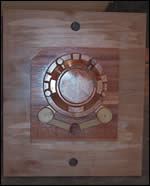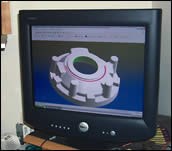Step Reduction Milling Reduces Roughing Cycle Time
Programming rough machining operations for efficient removal of large volumes of material is crucial when preparing a mold, pattern or other workpiece for finish machining. However, the strategies for traditional roughing operations, which are mainly based on rest roughing, require that each tool be programmed separately.
Share


Hwacheon Machinery America, Inc.
Featured Content
View More



Takumi USA
Featured Content
View More

.png;maxWidth=45)
DMG MORI - Cincinnati
Featured Content
View More


Programming rough machining operations for efficient removal of large volumes of material is crucial when preparing a mold, pattern or other workpiece for finish machining. However, the strategies for traditional roughing operations, which are mainly based on rest roughing, require that each tool be programmed separately.
Modacam Inc. (Denver, North Carolina), a pattern, mold and production job shop, is experiencing substantial time savings with an alternative to rest roughing from Surfware Inc. (Westlake Village, California). Step Reduction Milling (SRM) is an integrated component in the SurfCAM CAD/CAM system, which creates a single roughing program that can be used for machining molds and patterns, in addition to forging dies and parts.
"We estimate that SRM has cut our rough machining programming time in half," says Bud Tschudin, president of Modacam. "Because we can be more aggressive, rough machining cycle time has been reduced by 30 percent."
Shorter programming and machining cycle times are the result of the programmer working with a single dialog box and intelligent knowledge base. The technology analyzes the capabilities and limitations of all tools in the list and uses them together, as a cohesive group, to produce the appropriate roughing program.
In moldmaking and pattern making, traditional roughing methods used for machining complex surfaces leave behind excess material in the form of steps. Rest roughing requires that each cutting tool be programmed independently, with the NC programmer having sole knowledge of the other cutting tools being used. Then, a time-consuming analysis must be performed for each cutting tool to determine the location of the excess material. At this point, preparing the material for subsequent tools becomes problematic because individual cutting tools have no knowledge of which tools will follow. This necessitates smaller tools removing more material than recommended, while the larger tools remove less material than they should. Typically, the remaining steps do not have a uniform height, making it difficult to maintain an even cutting load during the finishing process. Tool load, and therefore tool wear, varies, and the possibility of broken tools increases. To minimize the impact of these problems, programmers often rely on smaller tools and less aggressive cutting, which further increases machining cycle time.
According to the Modacam, SRM eliminates the need for rest roughing. Using a combination of multiple tools, automation and shop-floor machining logic, the component creates a roughing program that produces uniform step heights, regardless of the sizes and number of tools used. This results in shorter programming and machining cycle times. The process also promotes the use of larger cutting tools to remove more stock with reductions in the number of steps required to prepare for the following tool. A uniform amount of material is left behind for finishing, thus accommodating the application of constant loads to the cutting tools, all of which minimizes tool wear and the likelihood of tool breakage.
Lights-out machining is an essential strategy employed by the company to sustain its competitive edge. "For us, lights-out machining is a big deal," says Jonathan Elrod, a programmer at the company."We have confidence that the finishing operation is going to run smoothly overnight, when no one is here. A consistent step is being removed, so we can take roughing operations down to the finished cutting tool size. In essence, it's like adding a second or third shift without increasing labor costs."
"SurfCAM with SRM has been essential in cutting our costs and improving our delivery time," Mr. Tschudin says. With optimized operations, the company is able to take on jobs that were otherwise unattainable, while maximizing profits.
Read Next
Registration Now Open for the Precision Machining Technology Show (PMTS) 2025
The precision machining industry’s premier event returns to Cleveland, OH, April 1-3.
Read More5 Rules of Thumb for Buying CNC Machine Tools
Use these tips to carefully plan your machine tool purchases and to avoid regretting your decision later.
Read MoreBuilding Out a Foundation for Student Machinists
Autodesk and Haas have teamed up to produce an introductory course for students that covers the basics of CAD, CAM and CNC while providing them with a portfolio part.
Read More
































.jpg;maxWidth=300;quality=90)









